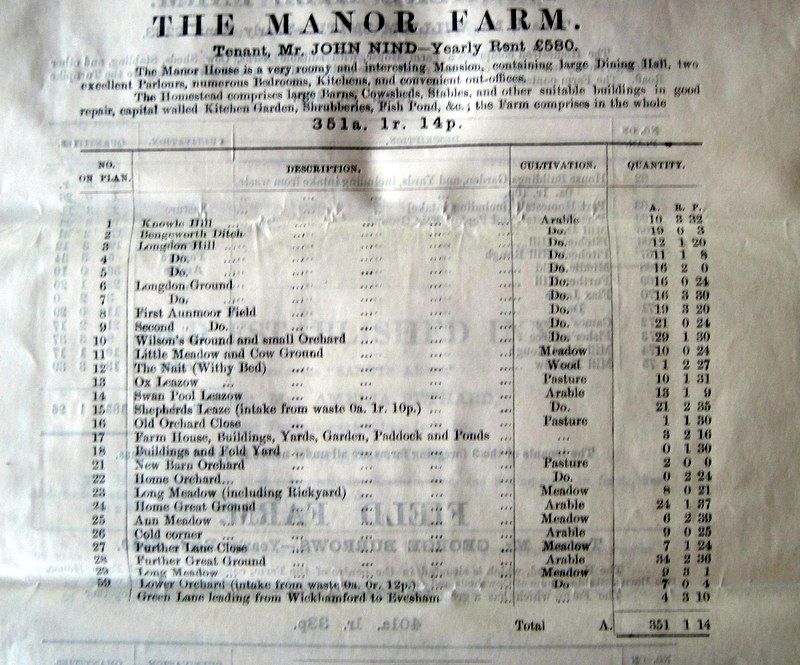Augustus Frederick Arthur Sandys (1840-1904), the eldest son of Arthur Marcus Cecil and Louisa Hill became 4th Baron Sandys of Ombersley in 1863 on the death of his father. Presumably, after the death of the 3rd Baron, the family decided to sell the Wickhamford Estate, which had not been lived in by the family for over 160 years.

A description of the properties and land to be sold was given in a leaflet produced by the Auctioneers, Bentley and Hill, charged with disposing of the Estate (2). The Estate was described as ‘The Manor or Lordship or Reputed Manor or Lordship of Wickhamford’. The solicitor handling the sale was Martin Curtler of Worcester. This leaflet suggested that the auction would take place in June of 1869 at the Star Hotel, Worcester. The main properties of the Estate were listed as Manor Farm, Elms Farm, Pitcher’s Hill Farm, Field Farm, The Mill and the Sandys Arms Inn. Other properties ‘20 Labourers Cottages, two of them newly built’. The estate was said to be very suitable for ‘Orcharding or Garden Land’.
The Worcester Chronicle of 31st March 1869 announced that the Wickhamford Estate was to be sold in the summer. It said ‘the whole lies well together and in a ring fence’, bounded by lands of Miss Porter, William Laslett Esq. M.P., Capt Lord &c.

The auction was eventually held on Saturday 10th July 1869 at the Star Hotel, Foregate St, Worcester and more detailed Particulars were produced (3) together with a map of the Wickhamford Estate (4). It also mentioned that a trout stream with an unfailing supply of excellent water flowed through the Estate.

(now mentioning 24 Labourers’ Cottages)

The sale was to consist of two Lots. Lot 1 consisted of the bulk of the parish of Wickhamford and Lot 2 was two small areas of land in Aldington and in Badsey. At this time only Field Farm and Wickhamford Mill were to the south of the Turnpike Road from Evesham to Oxford. Adjacent to the road were the Sandys Arms and a cottage on the opposite side of the village street. There were no other buildings along the Turnpike Road as it crossed Longdon Hill and Pitcher’s Hill. The rest of the village properties were along the village street from the Turnpike Road to the Church. The Wickhamford Estate, Particulars and Plan (5) gave the total area of land as 1,203 acres, 3 roods and 1 perch, producing a gross rental of £1,760 a year.

Detailed descriptions of The Manor Farm (7), The Elms Farm (8), Pitcher’s Hill Farm (9), Field Farm (10), Wickhamford Mill (11) and the Sandys Arms (12) were given, room by room and field by field. The extent of the farms is shown in the small map (6).



All four farms had arable fields and pasture land for grazing; all of the farms were equipped with cow sheds. The land adjacent to the brook would have been prone to seasonal flooding and these fields are usually referred to as meadows. In the 1871 census most of the men in the village were farm labourers, plus some shepherds and carters.

(Pitcher’s Hill Farm is now ‘Wickham Farm’ and the original farmhouse is now called ‘Wickham House’, having been sold off from the farm in the 1940s.)



In each case the tenant was named, the length of the lease given and the yearly rent paid. In the 1861 census there were 28 properties of all sizes in the village and this had increase to 30 by 1871. Most of these were labourers’ cottages that were to be demolished in future years (13). The Particulars give the names of the tenants of these cottages in 1869 (14) & (15) and in most cases these are the men and women listed in the 1871 census in the village.





The Worcester Chronicle of Saturday 17th July 1869 reported the Estate had been offered for sale with a large attendance. Bidding had commenced at £30,000 but quickly ran up to £45,000. After that it were confined to Mr Laslett, M.P. and Mr F Parker, whose last bid was £47,600. Mr Martin Curtler announced that the reserve was £60,000 and therefore the Estate was not sold.
A few days later, the Worcester Chronicle of Wednesday 21st July stated that since the auction last week the Wickhamford Estate had been sold for £50,000 to Mr Francis Parker, as agent to J.P. Lord of Hallow Park.
On 12th October 1869, an indenture was made between between Sir Edmund Filmer of the first part, the Right Honourable Augustus Frederick Arthur, Lord Sandys, Baron Sandys of the second part, John Pickup Lord of the third part and Richard Barlow Dodgson and Francis Parker of the fourth part, which was a conveyance of the Manor and all the manorial land in Wickhamford from Lord Sandys to John Pickup Lord, with Dodgson and Parker as trustees.
J. P. Lord transformed the village over the next few years, demolishing most of the poorer cottages and building pairs of brick and slate houses for the farm workers on the village street and Longdon Hill.
Tom Locke and Val Harman – March 2014
